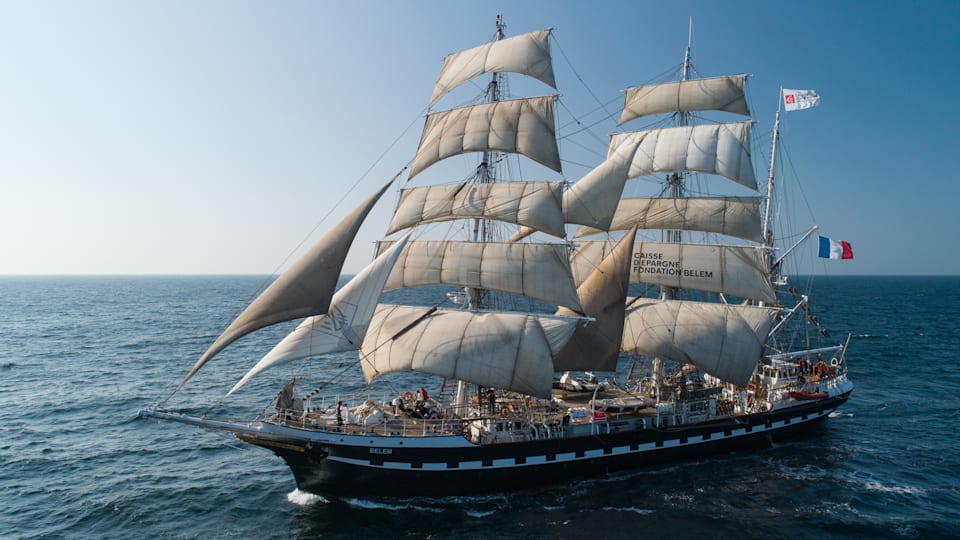The Belem: Everything you need to know about the iconic ship as the Olympic flame heads to France

In 1896 the first Olympic Games of the modern era took place in Greece. That same year, approximately 2,000 kilometres away at a shipyard in France, the Belem was born.
More than a century later, the Games will finally bring them together.
On 27 April, the Olympic flame will leave Greece aboard the Belem, Europe's oldest three-masted barque, and set sail towards France, the host country of the Olympic Games Paris 2024.
The 12-day voyage between Piraeus and Marseille will add another chapter to the remarkable story of the ship, which was honoured as a historic monument 40 years ago.
Merchant vessel, yacht and training ship: the three lives of the Belem
The Belem has crossed many seas, but had even more adventures. Today, the ship is one of the oldest of its kind, which is a remarkable feat considering its early brushes with disaster.
A fire broke out onboard the ship during its maiden voyage to Belem, the port city in Brazil that lends its name to the iconic vessel, but it was able to continue its inaugural visit after undergoing repairs in France.
After several transatlantic voyages transporting cocoa, rum and sugar to France, the Belem managed to survive another tragedy: the Montagne Pelée eruption in 1902.
The city of Saint-Pierre in Martinique was destroyed and more than 30,000 people lost their lives in the disaster, but the Belem somehow managed to escape without any damage.
Fortuitously, due to a lack of space in the harbour the day before, the ship docked in another bay safely away from the city.
But nothing could prevent the Belem from the rise of steamships. Gradually, its commercial use transporting goods began to decrease and in 1914 was sold to the Duke of Westminster.
The Belem was turned into a yacht and a few years later was purchased by the Irish engineer and brewer Sir Arthur Ernest Guinness, who changed the ship’s name to Fantôme II.
After a trip around the world and a few decades later, the ship was sold once again; this time to an Italian charity, and it was re-named Giorgio Cini after the non-profit organisation which now owned it.
The boat, originally constructed in a Nantes shipyard, was transformed into a training ship and for the next 15 years sailed across the Mediterranean before technology caught up with the vessel once more.
By the 1960s, considered too old and too small, the Giorgio Cini never left harbour. It was handed over to the carabinieri (Italian police) for training, and when they decided it was no longer fit for purpose, they sold the vessel for one symbolic lira (around €0.01) to a shipyard in Venice.
As restoration costs spiralled, it wasn’t long before the barque was back on the market.
Historic monument and Olympic Games London 2012
The National Union of Savings Banks of France (L’Union Nationale des Caisse d'Epargne de France) and the Navy (Marine Nationale) bought the Belem in 1979 and handled its restoration over the years that followed.
Due to these efforts, on 27 February 1984, the Belem joined a prestigious list of historic monuments.
The honour gave the ship back its prestige and captured the country’s imagination as it became an iconic vessel among sailing boats. It remains a training ship to this day, and every year welcomes aboard thousands of visitors who discover life on the open sea.
When there are no interns pulling up its sails, the Belem travels the world to represent France on the international stage; celebrating everything from the Statue of Liberty's centenary in New York to Queen Elizabeth II's jubilee in London.
The Belem stayed in the UK capital city that particular year - crossing Tower Bridge and docking on the Thames to great fanfare - as it hosted families of French athletes competing at the Olympic Games London 2012.
Twelve years later the Belem will drop its anchor in Olympic waters once again, as Marseille kick-starts the celebration of a lifetime.
The Belem in numbers
- Length: 58m
- Height: 34m (above sea level)
- Maximum engine speed: 9.2 knots (approximately 17km/h)
- Number of voyages: 33 (between 1896 and 1914)
- Construction time: 6 months
- First launched: 10 June 1896
Related content